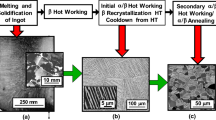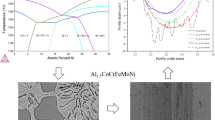Abstract
The object of the paper is to examine the effects of alloy purity and state of aging on the fracture mechanism and resultant toughness of pure Al-Cu alloys, and commercial duralumin. In pure alloys, the transition from a shear to an intergranular mode of fracture with overaging is associated with changes in the nature and size of the matrix precipitate, which affect the slip character. In the corresponding commercial purity alloys, no such fracture mode transition occurs. The presence of second-phase dispersoids inhibits planar slip, and in the overaged state inclusion-matrix interfaces present a suitable alternative site to the grain boundaries for strain accumulation, resulting in debonding leading to the initiation of voids, which subsequently grow and coalesce. The fracture toughness, as conventionally measured, indicates the material’s resistance to crack initiation rather than propagation and is effectively independent of fracture mode. The work hardening capacity has a marked effect on void size, and is shown to be a sensitive indicator of fracture toughness in both pure and commercial alloys. Based on a simple model, good agreement is obtained between experimental results of toughness and those predicted from a knowledge of the tensile properties.
Similar content being viewed by others
References
A. Kelly and R. B. Nicholson:Progr. Mater. Sci., 1963, vol. 10, p. 15.
J. G. Kaufman and H. Y. Hunsicker: ASTM, STP 381, p. 290,1965.
R. Develay:Metals and Materials, vol. 6, p. 404, 1972.
H. Y. Hunsicker:Aluminium, K. van Horn, ed., vol. 1, p. 148,ASM, 1967.
P. J. Guest:M.Sc. Thesis, Report No. UCRL 27872, University of California, 1967.
I. Kirman:Met. Trans., 1971, vol. 2, p. 1761.
P. N. T. Unwin and G. C. Smith:J. Inst. Metals, 1969, vol. 96, p. 299.
G. T. Hahn and A. R. Rosenfield:Met. Trans. A, 1975, vol. 6A, p. 653.
R. A. Queeney:Met. Trans., 1974, vol. 5, p. 308.
British Standard: B.S. DD3, Draft for Development, Fracture Toughness Testing.
R. O. Ritchie, G. G. Garrett, and J. F. Knott:Int. J. Fract. Mech., 1971, vol. 7, p. 462.
J. Davies, D. F. Cannon, and R.J. Allen:Nature, 1970, vol. 225, p. 1240.
J. M. Lowes and G. D. Fearnehough:Eng. Fract. Mech., 1971, vol. 3, p. 103.
G. G. Garrett: Ph.D. Thesis, University of Cambridge, 1973.
J. M. Krafft and G. R. Irwin: ASTM, STP 381, p. 114, 1965.
L. Roesch and G. Henry: ASTM, STP 453, p. 26, 1969.
H. C.Burghard:Met. Trans., 1974, vol. 5, p. 2083.
G. Thomas and J. Nutting:J. Inst. Metals, 1959, vol. 88, p. 81.
N. Ryurm.Acta Met., 1968, vol. 16, p. 327.
R. W. Bauer and H. G. F. Wilsdorf:Scr. Met., 1973, vol. 7, p. 1213.
H. P. van Leeuwen.et al..: NLRTR 70, p. 105, Nat. Aero. Lab., Holland, 1971.
A. J. DeArdo: Ph.D. Thesis, Carnegie-Mellon University, 1970.
G. Greetham and R. W. Honeycombe:J. Inst. Metals, 1960, vol. 89, p. 13.
J. Silcock:Acta Met., 1960, vol. 8, p. 589.
J. Byrne, M. Fine, and A. Kelly:Phil. Mag., 1961, ser. 8, p. 440.
G. Thomas and J. Nutting:J. Inst. Metals, 1957, vol. 86. p. 7.
W.J.Plumbridge and D. A. Ryder:Met. Rev., 1969, vol. 3, no. 8.
C. Laird: ASTM, STP 415, p. 131, 1967.
P. R. Swann:Electron Microscopy and the Strength of Crystals, G. Thomas and J. Washburn, eds., p. 861, J. Wiley & Sons, 1963.
B. K. Park,et al.: AFML-TR-70-195, American AF Report, 1970.
T. B. Cox and J. R. Low, Jr.:Met. Trans., 1974, vol. 5, p. 459.
D. S. Thompson and S. A. Levy: AFML-TR-70-171, Wright-Patterson AFB, Ohio, 1970 (as reported in Ref. 8).
C. J. Peel, R. N. Wilson, and P. J. E. Forsyth:Metal Sci. J., 1972, vol. 6, p. 102.
D. Broek: Ph.D. Thesis, Delft University, 1971.
J. R. Low. Jr., R. H. Van Stone, and R. H. Merchant: NASA Tech. Rept. No. 2, NGR 38-087-003, Carnegie-Mellon University, 1972.
T. B. Cox and J. R. Low: NASA Tech. Rept. No. 3, NGR 38-087-003, Carnegie- Mellon University, 1972 (as reported in Ref. 8).
R. H. Van Stone and J. A. Psioda:Met. Trans. A, 1975, vol. 6A, p. 668.
G. T. Hahn and A. R. Rosenfield:Third Int. Conf. on Fracture, Paper PL-III-211, Munich, 1973.
J. R. Rice and M. A. Johnson:Inelastic Behaviour of Materials, M. F. Kanninen, ed., p. 641, McGraw-Hill, 1970.
J. G. Kaufman, R. L. Moore, and P. E. Schilling:Eng. Fract. Mech., 1971, vol. 2, p. 197.
R. H. Van Stone, R. H. Merchant, and J. R. Low: ASTM, STP 556, p. 53, 1974.
W. W. Gerberich:Exp. Mech., 1964, vol. 4, p. 335.
G. T. Hahn and A. R. Rosenfield: ASTM, STP 432, p. 5, 1968.
J. R. Rice:Third Int. Conf. on Fracture, Paper J-441, Munich, 1973.
R. O. Ritchie, J. F. Knott, and J. R. Rice:J. Mech. Phys. Sol., 1973, vol. 21, p. 395.
D. Broek:Eng. Fract. Mech., 1973, vol. 5, p. 55.
J. N. Robinson and A. S. Tetelman:Third Int. Conf. on Fracture, Paper 11-421, Munich, 1973.
S. A. Mohammed and A. S. Tetelman:Ibid., Paper 11-511.
J. S. Ke and H. W. Liu:Eng. Fract. Mech., 1976, vol. 8, p. 425.
J. M. Krafft:Appl. Mater. Res., 1964, vol. 3, p. 88.
P. F. Thomason:Int. J. Fract. Mech., 1971, vol. 7, p. 409.
M. I. Baskes:Eng. Fract. Mech., 1974, vol. 6, p. 11.
G. Green, R. F. Smith, and J. F. Knott:Mechanics and Mechanisms of Crack Growth, p. 58, British Steel Corporation, Cambridge, 1973.
F. A. Johnson and J. G. Radon:Int. J. Fract. Mech., 1972, vol. 8, p. 21.
A. W. Thompson and P. F. Weihrauch:Scr. Met., 1976, vol. 10, p. 205.
Author information
Authors and Affiliations
Rights and permissions
About this article
Cite this article
Garrett, G.G., Knott, J.F. The influence of compositional and microstructural variations on the mechanism of static fracture in aluminum alloys. Metall Trans A 9, 1187–1201 (1978). https://doi.org/10.1007/BF02652242
Received:
Issue Date:
DOI: https://doi.org/10.1007/BF02652242




